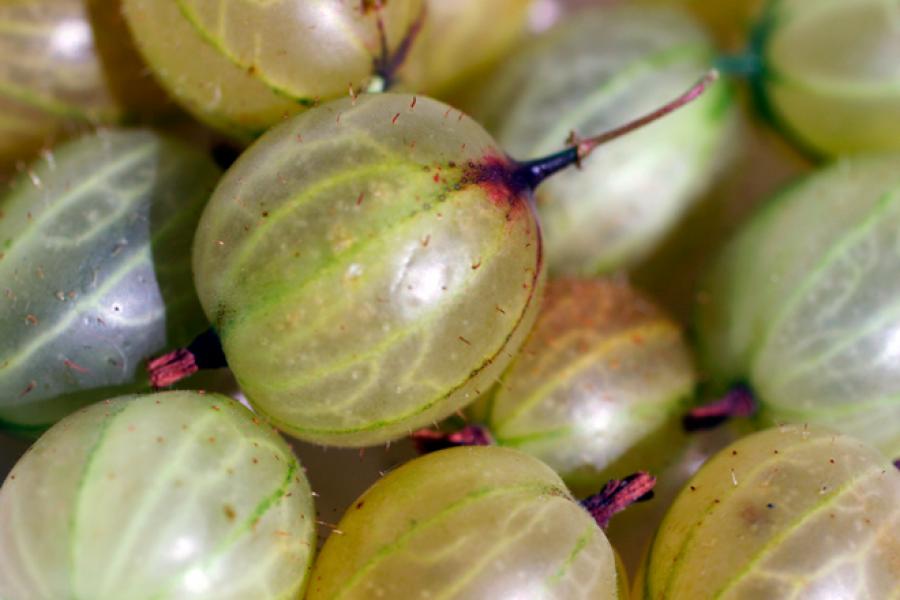Gooseberry
Gooseberries are used to make juices, jams and cakes, they can be great in other dishes.
You may not find bunches of gooseberry in your local grocery market, but if you look on many of the natural carbonated juices you find on the shelf, chances are you will find gooseberry listed as one of the ingredients. From juices to wines and jams to pastries, gooseberry is a rather sweet and crisp taste and looks like you mashed together a grape and a water melon rind. If you happen to come across some fresh gooseberries, be sure to pick them up and experiment with them in your kitchen. You will be pleasantly surprised with your end results.
Gooseberries give healthy benefits
The gooseberry plant is indigenous to many parts of Europe and Asia, growing naturally in thickets and rocky wooded areas, from France to the Himalayas. In England, gooseberry bushes are often found around old ruins, being once cultivated but long forgotten, but are difficult to distinguish from the feral ones that fit into the natural fauna and flora. Gooseberries are edible soft fruits with a thin, translucent skin bearing some hair and they can be yellow, green or red in color. Gooseberries vary in bitterness, and some varieties are far too bitter to be eaten raw. The less-bitter varieties of gooseberries work well when added to fruit salads or used to garnish dessert plates.
Gooseberry history facts
Though this intriguing berry grows wild in many locations throughout the continental United States, it's generally cultivated in tropical zones such as Hawaii, Australia, New Zealand, South Africa, Asia, and Central and South America. At first glance the cape gooseberry with its inflated, papery skin, looks somewhat like a Chinese lantern or a miniature watermelon on a stem. The bittersweet juicy berries that hide inside the skin are opaque and golden in color. Imported gooseberries are often available at fresh food markets from March to July when they are in season.
How to tell if wild berries are edible
How to eat gooseberries
To use the berries, peel back the parchment-like husk and rinse. Remove the stems and tops with scissors before eating or cooking. Gooseberries may be poached and eaten cooked or added to sugar or syrup for a sauce. To retain the shape of the berry, poach slowly. They are done when the seeds have escaped and the skins collapse. Gooseberries are often used as an ingredient in desserts, and are fantastic when the juice is used to flavor sodas, water, and even milk. Gooseberries can be made into wine or tea, too. They are also used as a secondary ingredient in pickling brine to help add flavor or preserved in sugar syrups for later use out of season.
If gooseberry is new to you, start exploring the possibilities by enjoying a juice or jam. You'll get the flavor and nutrition first, then you'll be ready to go find a fresh supply.
Goose berries could be used to make fruit wines.
Are gooseberries good for you?
Gooseberries are an excellent source of vitamin C, vitamin A, calcium, iron, and phosphorus. There are also high levels of potassium in gooseberries which help break up lactic acid which is especially helpful if you like to hit the gym often. Gooseberries have been shown to help reduce the signs of aging, especially with the high levels of antioxidants in the darker red and purple varieties. Gooseberry has also been used extensively in beauty products to help tighten and even skin tone. There is also data to show the reduction of hypertension and Precambrian, especially during pregnancy.
How to grow
Gooseberries are relatively easy to grow. The plans thrive in many kinds of soil, preferably in a sunny spot. Gooseberries can be grown as bushes, pruning to ensure a better yield of fruit. However, if space is at premium, gooseberries can be grown in containers or they can be trained against a wall so the plant will take up less garden space. Gooseberries do not need watering unless it is excessively dry and hot.
Harvest gooseberries from early to mid summer, taking some under-ripe berries early in summer for jams and pies and allowing the rest to grow into sweet, fully ripe fruit - protect gooseberries under a net as birds love them.
Gooseberry - varieties Greenfinch, Invicta, Leveller, Lancashire Lad, Whinham’s Industry.
ribes grossularia, ribes uva-crispa (Grossulariaceae)

